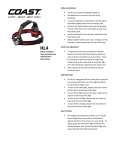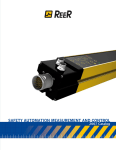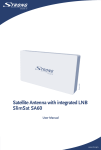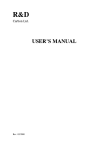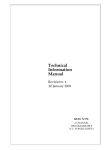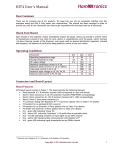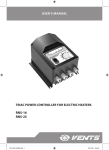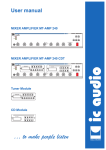Download EC-101 Intelligent Controller User Manual V1.1 - Xiamen E
Transcript
E-Caling(xiamen) Eelectronic Co.,LTD EC-101 Intelligent Controller User Manual V1.1 E-Caling(xiamen) Eelectronic Co.,LTD 1 E-Mail:[email protected] or [email protected] E-Caling(xiamen) Eelectronic Co.,LTD Content Unit 1 Introduction·······························································································3 1.1 Brief introduction 1.2 Model introduction 1.3 Outline dimension and Install Hole size 1.4 Main specification 1.5 Terminal connection Unit 2 Operation instruction ··············································································9 2.1 Panel introduction 2.2 States of the Instrument 2.3 Operation instruction 2.4 Parameters setting: 2.5 Parameters table: 2.5.1 For example introduction: 2.5.2 Alarm setting: 2.5.3 Cold-junction compensation: Unit 3 Function Introduction·············································································14 3.1 Alarm 3.2 Transform output 3.3 Pillar-light simulated display 3.3 Example Unit 4 Communication protocol·······································································16 4.1 Communication rules 4.2 Answer command format 4.3 Data format 4.4 Communication instruction 4.5 Parameter code table 2 E-Mail:[email protected] or [email protected] E-Caling(xiamen) Eelectronic Co.,LTD Unit 1 Introduction 1.1 Brief Instruction EC-101 intelligent controller is an intelligent and high-precision measuring and control instrument to display liquid level, temperature and pressure in digital. Equipped With level sensor, pressure sensor, temperature sensor and transducer it can make all ranges of measuring and control system for level, temperature and pressure. The input of EC-101 intelligent controller may be T.C, RTD, 0-10mA or 4-20mA standard current and 0-5V or 1-5V standard voltage, and it can be changed freely. There are four alarm outputs and each can be defined as upper limit alarm or lower limit alarm. The output can be standard current transform output of 0-10mA or 4-20mA and the sensor power supply output of 12VDC/50mA, 5VDC/50mA and 24VDC/50mA. Features ◆Adopting the most advanced ATMEL single chip Microcomputer reduce the peripheral components and improve its reliability; ◆integrate universal input, several output methods in one controller; ◆Adopt multi advanced techniques, such as WATCHDOG circuit, software trap & instruction redundancy, power-off protection, digital filter and so on, field fault-tolerant ability is highly paid attention to; all these techniques make the controller has strong anti-interference capability; ◆Adopting modularized output interface, the function configuration is convenient and flexible; ◆Double four-bit LED digital display, it can display measured value and the 1st alarm value; ◆With pillar-light of 20 segments display measured value; 1.2 Model introduction EC-101 Outline (mm) introduction dimension Main output Output 1(AL1) Output 2(AL2) A:96×96 B:48×96 C:96×48 D:160×80 E:80×160 F:72×72 G:48×48 N:None J1:Relay output(3A normal open + normal close) J2:Relay output (0.8A normal open) J3 : two channels of Relay output (0.8A normal open×2) T:Solid state relay triggering output (12V/40mA) N:None J:Relay output(3A normal open) T:Solid state relay triggering output (12V/40mA) N:None J:Relay output(3A normal open) T:Solid state relay triggering output (12V/40mA) V1:DC 12V/50mA sensor power supply V2:DC 24V/50mA sensor power supply V3:DC 5V/50mA sensor power supply V5: Voltage transform output 0-5V I:Current transform output (0-10mA 4-20mA) 3 E-Mail:[email protected] or [email protected] E-Caling(xiamen) Eelectronic Co.,LTD EC-101 introduction N:None V1:DC 12V/50mA sensor power supply V2:DC 24V/50mA sensor power supply V3:DC 5V/50mA sensor power supply Voltage transform output 0-5V I:Current transform output (0-10mA 4-20mA) Output 3(AL3) R: RS232 communication S: RS485 communication 0:Thermocouple, RTD, 0-5V, 1-5V 1:Thermocouple, RTD, 0-10mA, 4-20mA Input mode Remark:Note in the table“□”means,For example: EC-101A JJJV1,its means below EC-101 A J J J V 1 A: means 96×96mm J: means Relay main output J: means Relay secondary output 1 J :means Relay secondary output 2 V: means Voltage secondary output 3 1: means Thermocouple 1 input 1.3 Outline dimension and Install Hole size : Outline dimension code A Outline dimension code B Outline dimension code C Panel size: Panel size: 96(W)×96(H)×(D)105mm 96(W)×48(H)×(D)105mm 48(W)×96(H)×(D)105mm Install Hole size : 92(W)×92(H),D>105mm Install Hole size : 92(W)×45(H),D>105mm Install Hole size : 45(W)×92(H),D>105mm Install Hole size Panel size Panel size: 4 E-Mail:[email protected] or [email protected] E-Caling(xiamen) Eelectronic Co.,LTD Outline dimension code D Outline dimension code E Outline dimension code F Panel size: Panel size: 160(W)×80(H)×(D)105mm 80(W)×160(H)×(D)105mm 72(W)×72(H)×(D)105mm Install Hole size : 152(W)×76(H),D>105mm Install Hole size : 76(W)×152(H),D>105mm Install Hole size : 68(W)×68(H),D>105mm Install Hole size Panel size Panel size: Outline dimension code G Panel size: Install Hole size Panel size 48(W)×48(H)×(D)105mm Install Hole size : 45(W)×45(H),D>105mm 1.4 Main specification ◆ Accuracy: ±0.2% F.S ±1digit ◆ Power supply: 85V-264V or DC24V ◆ Power consumption: < 4w ◆ Ambient temperature: -15-60℃ ◆Ambient humidity: <85% RH ◆Input signal:(remark:Sensor error or over range: Sb) 5 E-Mail:[email protected] or [email protected] E-Caling(xiamen) Eelectronic Co.,LTD S.N. Input model 1 Thermocouple 2 3 RTD Standard current Standard voltage 4 Measuring range Code Input model Measuring range 0 1 2 3 8 Input model K S B T Pt100 0--1300℃ 0--1700℃ 0--1800℃ -200--400℃ -200--600℃ 4 5 6 7 9 E J Wre325 N Cu50 -200--1000℃ 0--800℃ 0--2300℃ 0--1300℃ -50--150℃ 14 DC 0-5V -999-9999 15 DC 1-5V -999-9999 16 4-20mA -999-9999 17 0 - 10mA -999-9999 Code ◆ Output Signal S.N. 1 Output mode Relay on/off output Current transform output Sensor power supply 2 3 Output 1 AC220V/3A Output 2 AC220V/1A Output / 3 0-19mA 4-20mA / DC24V/50mA DC12V/50mA DC5V/50mA ◆ Cold-junction compensation error: ±1 o C ◆ Resolution: 0.1℃ ◆ Display mode: 2 x 4 bit LED digital display, pillar-light of 20 segments ◆The sampling period:0.5s ◆ Control mode: the four alarm can be set as upper limit alarm or lower limit alarm freely. 1.5 Terminal Connection (please refer to the connection diagram on meter shell): 1) 96 X 96, 48 X 96(V), 80 X 96(V): Note: a) The output of EC-101 includes four parts: main control output (OUT), ALiliary output1 (AL1), ALiliary output2 (AL2), ALiliary output3 (AL3). The terminal function has multi definitions and it is determined by the function of the output interface mounted. The connection is based on black point symbol; b) The input of terminals “11” & “12” is 0-5V or 1-5V when delivery if not indicated when ordered. If the exact input is 0-10mA or 4-20mA, may parallel connect a 500ohm or 250ohm precision resistance to input terminals; c) c) If J3 is selected for main output, that is there are two channel’s alarm, terminal ’13’ & ‘14’ corresponds to the 4th alarm, the indicator corresponds to AL3; 6 + E-Mail:[email protected] or [email protected] E-Caling(xiamen) Eelectronic Co.,LTD 2) 96 X 48(H), 160 X 80(H): Note: a) The output of EC-101 includes four parts: main control output (OUT), ALiliary output1 (AL1), ALiliary output2 (AL2), ALiliary output3 (AL3). The terminal function has multi definitions and it is determined by the function of the output interface mounted. The connection is based on black point symbol; b) The input of terminals “11” & “12” is 0-5V or 1-5V when delivery if not indicated when ordered. If the exact input is 0-10mA or 4-20mA, may parallel connect a 500ohm or 250ohm precision resistance to input terminals; c) If J3 is selected for main output, that is there are two channel’s alarm, terminal ’13’ & ‘14’ corresponds to the 4th alarm, the indicator corresponds to AL3; 3)72 x 72 (H): Note: a) The output of the instruments includes three parts: main control output (OUT), ALiliary output1 (AL1), ALiliary output2 (AL2). The terminal function has multi definitions and it is determined by the function of the output interface mounted. The connection is based on black point symbol; b) The input of terminals “10” & “11” is 0-5V or 1-5V when delivery if not indicated when ordered. If the exact input is 0-10mA or 4-20mA, may parallel connect a 500ohm or 250ohm precision resistance to input terminals; 4)48 x 48: Note: a) The output of the instruments includes two parts: main control output (OUT), ALiliary output1 (AL1). The terminal function has multi definitions and it is determined by the function of the output interface mounted. The connection is based on black point symbol; b) The input of terminals “10” & “8” is 0-5V or 1-5V when delivery if not indicated when ordered. If the exact input is 0-10mA or 4-20mA, may parallel connect a 500ohm or 250ohm precision resistance to input terminals; 7 E-Mail:[email protected] or [email protected] E-Caling(xiamen) Eelectronic Co.,LTD c) There is no linear input option for the instruments when delivery, if the input signal is standard current or voltage, please move the jumper to the other two holes in the main output module (please refer to the diagram); Diagram of G type main board: 8 E-Mail:[email protected] or [email protected] E-Caling(xiamen) Eelectronic Co.,LTD Unit 2 Operation instruction 2.1 Panel introduction Take type A (96 × 96mm) as example: ⑴ (SET)button: ◆ Keep pressing more than 3 seconds to switch between normal display state and setting state; ◆ In setting state, press once to save the new set value of parameters and select the next parameter to be set; ⑵ (A/M)button:A:means auto,M:means manual,and moves the cursor toward left In setting state,used for moving the point toward the left. ⑶ UP button: In setting state,used for increasing Numbers. ⑷ Down button: In setting state,used for reducing Numbers. ⑸Upper display window(PV): ◆ In normal display state, it displays measured value。 ◆ In setting state, it displays the symbol of parameter to be set ⑹Lower display window (SV): ◆In normal display state, it displays the 1st alarm value; ◆In setting state, it displays the set value of the selected parameter; ⑺ OUT:the first alarm indicator 9 E-Mail:[email protected] or [email protected] E-Caling(xiamen) Eelectronic Co.,LTD OUT indicator is on when it meets the condition of the first alarm and the first alarm output terminals 15 & 16 close at the same time; contrarily, out indicator is off and the first alarm output terminals open. ⑻ AL1:the second alarm indicator indicator is on when it meets the condition of the second alarm and the second alarm output terminals 3 & 4 close at the same time; contrarily, AUX1 indicator is off and the second alarm output terminals open. ⑼ AL2:the third alarm indicator indicator is on when it meets the condition of the third alarm and the third alarm output terminals 5 & 6 close at the same time; contrarily, AUX2 indicator is off and the third alarm output terminals open; ⑽ AL3:the fourth alarm indicator indicator is on when it meets the condition of the fourth alarm and the fourth alarm output terminals 7 & 8 or 13 & 14 close at the same time; contrarily, AUX3 indicator is off and the fourth alarm output terminals open. 1) ⑾ 20 segments pillar-light It is used to display the measured value in simulation and its corresponding measured value is determined by LoL and HiL. 2.2 States of the Instrument Normal state: When the instruments work in the normal state, upper window displays measured value and lower window displays the first alarm value; Setting state: When the instruments work in parameters setting state, upper window displays the parameters to be set and lower window displays the set value of the parameters. 2.3 Operation instruction Power on self test 1、Connect the instrument correctly according to the terminal connection diagram on shell: power (terminal 1 & 2), input, output and alarm; 2、Check the connection carefully and make sure it is correct, then turn power on; 3、The instrument enters self test state at once when power on. Upper window (PV) displays measured value; lower window (SV) displays the first alarm value. If there is error, upper window (PV) displays ‘SYS’ and lower window (SV) displays ‘Err’. 2.4 Parameters setting: Brief introduction of Parameter Setting In the normal display state, keep pressing for 3 seconds, the system will enter parameter setting state. In setting state, press normal state. once to amend the next parameter; keep pressing for 3 seconds to enter 10 E-Mail:[email protected] or [email protected] E-Caling(xiamen) Eelectronic Co.,LTD 2.5 Parameters table: Symbol Parameter definition Setting range Notes Loc ON: enable parameter change; Parameter modification enable ON/OFF OFF: disable parameter change HL1 The first alarm mode ON/OFF ON: upper limit alarm OFF: lower limit alarm HL2 The second alarm mode ON/OFF ON: upper limit alarm OFF: lower limit alarm HL3 The third alarm mode ON/OFF ON: upper limit alarm OFF: lower limit alarm HL4 The fourth alarm mode ON/OFF ON: upper limit alarm OFF: lower limit alarm cP Cold junction compensation Poin Decimal point determined ON/OFF Cold-junction automatic/ no compensation --.-/--- When -100<display value<1000, the decimal point is at digit of tens’, or else at digit of ones. --.--/-.---oSEt Zeroing coefficient LoL Lower limit of analog display -99.9-99.9 Display value=measured value + oSEt Linear input 0mA,4mA,0V and 1V, Lower limit of linear input Display value corresponding to transform output of -999-9999 HiL Display value corresponding to 0mA or 4mA lower limit of transform output lower limit of analog display value Upper limit of analog display Linear input 10mA,20mA,5V and 10V, Upper limit of linear input range Display value corresponding to Transform output of -999-9999 Hy Display value corresponding to upper 10mA or 20mA limit of transform output upper limit of analog display value Hystersis of alarm 0-25.5 non-sensitive area of alarm Sn 0:K, 1:S, 2:B, 3:T, 4:E, 5:J, 6:Wre, 7:N, 8:Pt100, Input type 0-17 9:Cu50, 10:Cu100, 14:0-5V, 16: 4-20mA, 17:0-10mA FiL Input filter coefficient 0-100 oP No filter function when it is 0 0-10 0-10mA current output Transform output mode 4-20 4-20mA current output Remark:In the table set range for alarm value:-999-9999 11 E-Mail:[email protected] or [email protected] E-Caling(xiamen) Eelectronic Co.,LTD 2.5.1 For example introduction: Set parameter HiL to be 800,and the original set value is 600 ①Keep pressing SET for 3 seconds, the system enters ④ Press A/M to move the cursor to hundreds ②Unlock by pressing UP or DOWN ⑤ Press UP to set the hundreds digit to be 8 ③Press SET several times until the upper ⑥ After finishing the setting, keep pressing SET for 3 seconds to exit from parameter 2.5.2 Alarm setting: The instruments have four channels alarm; the alarm may be set to be upper limit and lower limit alarm via setting alarm mode parameter (HL1, HL2, HL3 and HL4). Example: the alarm output is upper limit alarm, user just need to set HL1, HL2, HL3 and HL4 to be ‘ON’; Example: adopts the 1st alarm and set it to be upper limit alarm; when the temperature beyond 2000℃ the 1st alarm output terminals close; ① Keep pressing SET for 3 seconds, the system enters parameter setting state; ② Unlock by pressing UP or DOWN; ③ Press SET several times, until upper window displays HL1; press UP button to set it to be ‘ON’; 12 E-Mail:[email protected] or [email protected] E-Caling(xiamen) Eelectronic Co.,LTD ④ Press SET to select ⑤ Press A/M to move the ⑤Press UP and DOWN to parameter OUT1, the ones point . set OUT1 to be 2000. ⑥After finishing the Setting, keep 2.5.3 Cold-junction compensation: When the input is thermocouple, and cold-junction compensation is needed, parameter cP should be ‘ON’. Linear input If the input is standard current or voltage, such as the output of the transmitter of level, pressure and temperature, the lower limit of linear input LoL and the upper limit of linear input HiL should be set according to the nominal value. For example, the instrument is connected with level transmitter, the output of the transmitter is 4-20mA and the corresponding pressure is 0m-10m, the parameter should be set as follow: Poin= - - -. – Or Poin= - -. – Sn=16 Sn=16 LoL=0.0 LoL=0.00 HiL=10.0 HiL=10.00 Input Type For set range of input type parameter Sn, please refer to parameter table; Example: if the input is 4-20mA, then Sn should be 16; Input Type For set range of input type parameter Sn, please refer to parameter table; Example: if the input is 4-20mA, then Sn should be 16; 2.5.4 Transform output The transform output of the instruments can be set to be 0-10mA or 4-20mA freely. The transform range is determined by parameter LoL and HiL, Example: The measured value is for temperature, set: LoL=0 HiL=100 oP=4-20 When measured value is more than or equal to 100℃, the transform output is 20mA; 13 E-Mail:[email protected] or [email protected] E-Caling(xiamen) Eelectronic Co.,LTD When measured value is 50℃, the transform output is 12mA. Note: As to linear current input (0-10mA, 4-20mA) and linear voltage input (0-5V, 1-5V), only one kind can be chosen when ordering. Without specification, the linear voltage input (0-5V, 1-5V) is adopted; if the field input is current, please parallel connect a precision resistor between the input terminals: if the field input is 0-10mA, please parallel connect a resistor of 500ohm, and set Sn to be 14; if the field input is 4-20mA, please parallel connect a resistor of 250ohm, and set Sn to be 15. Unit 3 Function introduction 3.1 Alarm a) When measured value is less than lower limit, the indicator is on and alarm contact close; b) When measured value is bigger than upper limit, the indicator is on and alarm contact close; c) Alarm hytersis (Hy) Upper limit alarm Lower limit alarm OUT+Hy OUT+Hy OUT OUT OUT-Hy OUT-Hy OFF ON OFF OFF Figure 1 ON OFF Figure 2 In order to avoid the frequent action of alarm output when the measured value is fluctuating at the critical point of alarm, the parameter of alarm hytersis Hy is used. When measured value increases to OUT1+Hy, upper limit alarm exports; when measured value decreases to OUT1, the alarm does not stop; only when measured value is less than OUT1-Hy, the alarm stops; refer to Figure 1. When measured value decreases to OUT1-Hy, lower limit alarm exports; when measured value increases to OUT1+Hy, lower limit alarm stops; refer to Figure 2. 3.2 Transform Output The measured value can be converted to 0-10mA or 4-20mA standard current. The current output form is determined by parameter oP and the transform range of measured value is determined by the parameters LoL and HiL. 1) When the input is linear, the transform output is the conversion output of the input signal. For example, assume the input is 0-10mA (Sn=17) and transform output is 4-20mA (oP=4-20), when the input is 14 E-Mail:[email protected] or [email protected] E-Caling(xiamen) Eelectronic Co.,LTD 0mA, the output is 4mA; when the input is 10mA, the output is 20mA. When the input is thermocouple or RTD, the transform output range is determined by LoL and HiL. 2) For example, if LoL=200, HiL=800 and oP=4-20, when the measured value is 200 o C , the output is 4mA; when the measured value is 800 o C , the output is 20mA. 3.3 Pillar-light simulated display There are 20 segments pillar-light to display measured value, the display range is determined by LoL and HiL: When measured value is less than or equal to LoL set value, the pillar-light are all off; When LoL set value<measured value<HiL set value, the segments of alighted pillar-light is proportional to the measured value; When measured value is bigger than or equal to HiL set value, t the pillar-light are all on. 3.4 Example 3.4.1 The instrument is used to control liquid level, and when the level is higher than 9m, upper limit alarm exports; when the level is lower than 2m, lower limit alarm export. The liquid level transmitter is of 2-wire 4-20mA output and the corresponding value is 0-10m; the parameters are set as follows: HL1=oN, LoL=0.0 HL2=oFF, HiL=10.0 Poin=---.-, Hy=0.2 OUT1=9.0, Sn=16 OUT2=2.0 3.4.2 Connection Example 85-265VAC Alarm 2 _ DC24V 2-wire Transmitter + 4-20mA 1 9 2 10 3 11 4 12 5 13 6 14 7 15 16 8 _ + Alarm 1 Sn=16 LoL=**** (lower limit of transmitter measuring range) LiL=**** (upper limit of transmitter measuring range) 15 E-Mail:[email protected] or [email protected] E-Caling(xiamen) Eelectronic Co.,LTD 85-265VAC Alarm 2 _ Remote DC5V Pressure + Transducer 1 9 2 10 3 11 4 12 5 13 6 14 7 15 16 8 _ + Alarm 1 Sn=14 LoL=**** (lower limit of transducer measuring range) LiL=**** (upper limit of transducer measuring range) Unit 4 Communication protocol 4.1 Communication rules LU-904M adopts asynchronous serial communication, can be equipped with RS-232C, RS422A or RS485 communication interface, and may communicate with baud rate of 1200-9600. Format of serial data frame is 1 start bit (bit 0), 8 data bit (bit 1-8), 1 addressing bit (bit 9) and 1 stop bit, total 11 bits; the data is hex. 4.2 Answer command format In each communication instruction, the instrument returns following message at the end: or 4FH 4BH (OK) means communication success 3FH 3FH (??) means communication fail 4.3 Data format 1) Data format: complement of two bytes. 2) Parameters with specified range. a) MV: range of current transform output, range: 0 – 200; MV=0 means current transform output is 0mA, and MV=200 means current transform output is 20mA; b) Status flag: range: 0 - FFH. 8 bits of it respectively represent 8 parameters of on/off; below pleas see the details. 7 HL4 6 5 4 3 cP HL3 2 1 0 HL2 HL1 Loc 16 E-Mail:[email protected] or [email protected] E-Caling(xiamen) Eelectronic Co.,LTD ‘1’ means ON, ‘0’ means OFF. c) oP: transform output mode; oP=2 means 0-10mA transform output; oP=3 means 4-20mA transform output; d) bAud: baud rate, range: 0-3, which means 1200, 2400, 4800 and 9600 respectively; Hy, Sn, FiL, oP, Addr, bAud and status flag are all parameters of single byte, so they should be filled with ‘0’ in high byte when written. 4.4 Communication instruction 4.4.1 Addressing instruction When the host computer wants to communicate with some instrument, it should send an addressing instruction first. The addressing instruction is single byte instruction, bit 1-8 is address and bit 9 is ‘1’ (Non-addressing instruction is ‘0’ ). The address of the instrument is determined by parameter Addr. The instrument make a cooperation of the address in the addressing instruction and the address of its own, if they are same, the instrument will start to communicate with the host computer. To the instrument in communication, if it receives an addressing instruction in which the address is not the address of its own, it will close the function of communication. For example, if the Addr of the instrument is 3, when it is addressed, the format is as follows: 0 1 1 0 0 0 0 0 0 1 0 1 2 3 4 5 6 7 8 9 4.4.2 Survey read (E) Instruction format: 45H Return value: PV, SV, MV, 4FH 4BH (OK) The low byte is at front and the high byte is behind, here SV is no meaning; 4.4.3 Read (R) Instruction format: 52H + parameter code Return value: parameter value + 4FH 4BH 4.4.4 Write (W) Instruction format: 57H + parameter code + parameter value Return value: 4FH 4BH 4.4.5 End instruction (O) Instruction format: 4FH or addressing instruction which is not for local machine (bit 9 is ‘1’); None return value. 17 E-Mail:[email protected] or [email protected] E-Caling(xiamen) Eelectronic Co.,LTD 4.5 Parameter code table Code Parameter Code Parameter Code Parameter Code Parameter 0 MV 6 OUT2 12 HiL 18 ---- 1 ---- 7 OUT3 13 Hy 19 ---- 2 Status Flag 8 OUT4 14 ---- 20 oP 3 ---- 9 oSEt 15 Sn 21 Addr 5 OUT1 11 LoL 16 FiL 22 bAud The distributed control system is characterized of centralized administration and distributed control, which is composed of Anthone intelligent instrument and superior computer. Control and data collection are done by inferior instrument. The superior computer performs real-time supervisory control of whole process, records and prints the history data. The fault of the superior computer does not affect the inferior instrument and there is no fault diffusion between inferior instruments for the distributed control. Therefore, it reduces the probability of system crash caused by local faults. Now the price of PC is very cheap and there is almost no limit of memory capacity, so it has good cost performance. Anthone DCS adopts RS485 communication rules when there are multi-set of instruments communicating and the max. Communication distance is 1km. One communication line is allowed to connect with 128 sets of Anthone serial intelligent instruments at most, and the system structure is very simple and convenient. For more information, please contact with the suppliers. 18 E-Mail:[email protected] or [email protected]



















